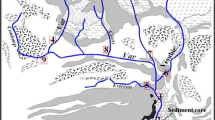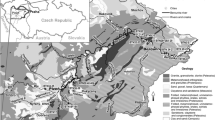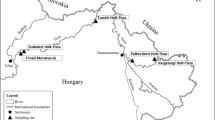Abstract
The Ría de Huelva is one of the most polluted areas in Western Europe because of the high acid mining activity together with the chemical industries located in its margins. This strong anthropogenic pressure results in the liberation of high concentrations of metals and rare earth elements (REEs) to the Ría. In this work, an Itrax™ Core Scanner (Itrax) has been used for the first time to detect and to study REEs distribution in a sediment core. Its high sensitivity (until 5 μg·g −1 for Er) was confirmed by comparing its semi-quantitative results with concentration values obtained from inductively coupled plasma mass spectrometry (ICP-MS). In this way, establishing equivalences between Itrax continuous data and concentration data have been possible to detect pollution levels caused by REEs and related trace elements along the whole sediment core reducing the discrete analyses and therefore saving time and money. Moreover, Itrax was confirmed as a fast screening and monitoring tool to study REEs fractionation patterns and to identify the environmental changes responsible of these patterns.






Similar content being viewed by others
References
Aarnes, I., Bjune, A. E., Birks, H. H., Balascio, N. L., Bakke, J., & Blaauw, M. (2012). Vegetation responses to rapid climatic changes during the last deglaciation 13,500–8,000 years ago on southwest Andøya, arctic Norway. Vegetation History and Archaeobotany, 21, 17–35.
Åström, M. (2001). Abundance and fractionation patterns of Rare Earth Elements in streams affected by acid sulphate soils. Chemical Geology, 175, 249–258.
Borrego, J., Morales, J. A., de la Torre, M. L., & Grande, J. A. (2002). Geochemical characteristics of heavy metal pollution in surface sediments of the Tinto and Odiel river estuary (southwestern Spain). Environmental Geology, 41, 785–796.
Borrego, J., López-González, N., Carro, B., & Coastal Geology Group. (2004a). a. Geochemical signature as paleoenvironmental markers in Holocene sediments of the Tinto River estuary (Southwestern Spain). Estuarine, Coastal and Shelf Science, 61, 631–641.
Borrego, J., López-González, N., Carro, B., & Lozano-Soria, O. (2004b). Origin of the anomalies in light and middle REE in sediments of an estuary affected by phosphogypsum wastes (south-western Spain). Marine Pollution Bulletin, 49, 1045–1053.
Borrego, J., López-González, N., Carro, B., & Lozano-Soria, O. (2005). Geochemistry of rare-earth elements in Holocene sediments of an acidic estuary: Environmental markers (Tinto River Estuary, South-Western Spain). Journal of Geochemical Exploration, 86, 119–129.
Borrego, J., Carro, B., López-González, N., de la Rosa, J., Grande, J. A., Gómez, T., & de la Torre, M. L. (2012). Effect of acid mine drainage on dissolved rare earth elements geochemistry along a fluvial—estuarine system: the Tinto-Odiel Estuary (S.W. Spain). Hydrology Research, 43(3), 262–274.
Borrego, J., Carro, B., Grande, J. A., de la Torre, M. L., Valente, T., & Santisteban, M. (2013). Control factors on the composition of superficial sediments in estuaries of the coast of Huelva (SW Spain): a statistical approach. Journal of Iberian Geology, 39(2), 223–232.
Caetano, M., Prego, R., Vale, C., de Pablo, H., & Marmolejo-Rodríguez, J. (2009). Record of diagenesis of rare earth elements and other metals in a transitional sedimentary environment. Marine Chemistry, 116, 36–46.
Carro, B., Borrego, J., López-González, N., Grande, J. A., Gómez, T., de la Torre, M. L., & Valente, T. (2011). Impact of acid mine drainage on the hydrogeochemical characteristics of the Tinto-Odiel Estuary (SW Spain). Journal of Iberian Geology, 37(1), 87–96.
Chester, R. (2000). Marine geochemistry. Cambridge: Cambridge University Press. 506 pp.
Croudace, I.W., Rindby, A., & Rothwell, R.G. (2006). ITRAX: description and evaluation of a new multi-function X-ray core scanner. In R.G. Rothwell (Ed.) New techniques in sediment core analysis. Geological Society, London, Special Publications 267, 51–63.
Davis, R. A., Jr., Welty, A. T., Borrego, J., Morales, J. A., Pendon, J. G., & Ryan, J. G. (2000). Rio Tinto estuary (Spain):5000 years of pollution. Environmental Geology, 39(10), 1107–1116.
Delgado, J., Pérez-López, R., Galván, L., Nieto, J. M., & Boski, T. (2012). Enrichment of rare earth elements as environmental tracers of contamination by acid mine drainage in salt marshes: a new perspective. Marine Pollution Bulletin, 64, 1799–1808.
Elbaz-Poulichet, F., & Dupuy, C. (1999). Behaviour of rare earth elements at the freshwater-seawater interface of two acid mine rivers: the Tinto and Odiel (Andalucia, Spain). Applied Geochemistry, 14, 1063–1072.
Elderfield, H., Hawkesworth, J., & Greaves, M. J. (1981). Rare earth element geochemistry of oceanic ferromanganese nodules and associated sediments. Geochimica et Cosmochimica Acta, 45, 513–528.
Gromet, L. P., Dymek, R. F., Haskin, R. A., & Korotev, R. L. (1984). The “North American shale composite”: its compilation, major and trace element characteristics. Geochimica et Cosmochimica Acta, 48, 2469–2482.
Haskin, M. A., & Haskin, L. A. (1966). Rare earths in European shales: a redetermination. Science, 154, 507–509.
Hierro, A., Bolivar, J. P., Vaca, F., & Borrego, J. (2012). Behavior of natural radionuclides in surficial sediments from an estuary impacted by acid mine discharge and industrial effluents in Southwest Spain. Journal of Environmental Radioactivity, 110, 13–23.
Kerrich, R., Polat, A., Wyman, D., & Hollings, P. (1999). Trace element systematics of Mg-, to Fe-tholeiitic basalt suites of the Superior Province: implications for Archean mantle reservoirs and greenstone belt genesis. Lithos, 46, 163–187.
Kimoto, A., Nearing, M. A., & Zhang, X. C. (2006). Applicability of rare earth element oxides as a sediment tracer for coarse-textured soils. Catena, 65, 214–221.
Lawrence, M. G., & Kamber, B. S. (2006). The behaviour of the rare earth elements during estuarine mixing-revisited. Marine Chemistry, 100, 147–161.
Leblanc, M., Morales, J. M., Borrego, J., & Elbaz-Poulichert, F. (2000). 4,500-year-old mining pollution in southwestern Spain: long-term implications for modern mining pollution. Economic Geology, 95, 655–661.
Leistel, J. M., Marcoux, E., Thieblemont, D., Quesada, C., Sanchez, A., Almodavar, G., Pascual, E., & Saez, R. (1998). The volcanic hosted massive sulphide deposits of the Iberian Pyrite Belt. Mineralium Deposita, 33, 2–30.
Lepland, A., Andersen, T. J., Lepland, A., Arp, H. P. H., Alve, E., Breedveld, G. D., & Rindby, A. (2010). Sedimentation and chronology of heavy metal pollution in Oslo harbor, Norway. Marine Pollution Bulletin, 60, 1512–1522.
Leybourne, M. I., Goodfellow, W. D., Boyle, D. R., & Hall, G. M. (2000). Rapid development of negative Ce anomalies in surface waters and contrasting REE patterns in groundwaters associated with Zn–Pb massive sulphide deposits. Applied Geochemistry, 15, 695–723.
Leybourne, M. I., Peter, J. M., Layton-Matthews, D., Volesky, J., & Boyle, D. R. (2006). Mobility and fractionation of rare earth elements during supergene weathering and gossan formation and chemical modification of massive sulfide gossan. Geochimica, 70, 1097–1112.
Liu, D., Wang, X., & Chen, Z. (2012). Effects of rare earth elements and ree-binding proteins on physiological responses in plants. Protein and Peptide Letters, 19, 198–202.
López-González, N., Borrego, J., Carro, B., & Lozano-Soria, O. (2005). Estudio de las concentraciones de REE y patrones de fraccionamiento en sedimentos superficiales del estuario de los ríos Tinto y Odiel (SO de España). Geogaceta, 37, 231–234.
López-González, N., Borrego, J., Carro, B., Grande, J. A., de la Torre, M. L., & Valente, T. (2012). Rare-earth-element fractionation patterns in estuarine sediments as a consequence of acid mine drainage: a case study in SW Spain. Boletín Geológico y Minero, 123(1), 55–64.
Machado, A., Rocha, F., Gomes, C., Dias, J. A., Araújo, M. F., & Gouveia, A. (2005). Mineralogical and geochemical characterisation of surficial sediments from the southwestern iberian continental shelf. Thalassas, 21(1), 67–76.
Martins, V. A., Dias, J. A., Laut, L. M., Sobrinho, F., Santos, J. F., Rodrigues, M. A., Frontalini, F., Miranda, P., Terroso, D., FernándezFernández, S., Ferreira, B., Bernardes, C., Figueira, R., Sousa, S., Amaral, P., Mahiques, M., Bernabeu, A., Rey, D., Rubio, B., & Rocha, F. (2013). Speciation of rare earth elements in surface sediments of Lagoon of Aveiro (N Portugal). Journal of Coastal Research, 65, 64–69.
McLennan, S.M. (1989). Rare earth elements in sedimentary rock: influence of provenance and sedimentary processes. In B.R. Lipin, G.A. Mckay (Eds.), Geochemistry and mineralogy of rare earth elements. pp. 169–200.
Meloni, S., & Genova, N. (1987). Rare-earth elements in the NBS standard reference materials spinach, orchard leaves, pine needles and bovine liver. The Science of the Total Environment, 64, 13–20.
Musashino, M. (1990). The Panthalassa-a cerium-rich Atlantic-type ocean: sedimentary environments of the Tamba Group, Southwest Japan. Tectonophysics, 181, 165–177.
Nelson, C. H., & Lamothe, P. J. (1993). Heavy metal anomalies in the Tinto and Odiel River and estuary system, Spain. Estuaries, 16, 496–511.
Nothdurft, L. D., Webb, G. E., & Kamber, B. S. (2004). Rare earth element geochemistry of Late Devonian reefal carbonates, Canning Basin, Western Australia: confirmation of a seawater proxy in ancient limestones. Geochimica et Cosmochimica Acta, 68, 263–283.
Nozaki, Y., Zhang, J., & Amakawa, H. (1997). The fractionation between Y and Ho in the marine environment. Earth and Planetary Science Letters, 148, 329–340.
Piper, D. Z. (1974). Rare earth elements in the sedimentary cycle: a summary. Chemical Geology, 14, 285–304.
Prego, R., Caetano, M., Vale, C., & Marmolejo-Rodríguez, J. (2009). Rare earth elements in sediments of the Vigo Ria, NW Iberian Peninsula. Continental Shelf Research, 29, 896–902.
Prego, R., Caetano, M., Bernardez, P., Brito, P., Ospina-Alvarez, N., & Vale, C. (2012). Rare earth elements in coastal sediments of the Northern Galician Shelf: influence of geological features. Continental Shelf Research, 35, 75–85.
Rebolledo, L., Sepúlveda, J., Lange, C. B., Pantoja, S., Bertrand, S., Hughen, K., & Figueroa, D. (2008). Late Holocene marine productivity changes in Northern Patagonia-Chile inferred from a multi-proxy analysis of Jacaf channel sediments. Estuarine, Coastal and Shelf Science, 80, 314–322.
Rodríguez-Germade, I., Rubio, B., Rey, D., Vilas, F., Martins, V., & Rocha, F. (2013). Evaluación de técnicas de procesado de datos geoquímicos en sedimentos marinos analizados con un Itrax Core Scanner. Geogaceta, 53, 85–88.
Rodríguez-Germade, I., Rubio, B., Rey, D., Vilas, F., López-Rodríguez, C.F., Comas, M.C., Martínez- Ruiz, F. (2015). Optimization of Itrax™ Core Scanner measurement conditions for sediments from submarine mud volcanoes. In Croudace I.W., Rothwell R.G. (Eds.) Micro-XRF studies of sediment cores.
Ruiz, F., González-Regalado, M. L., Borrego, J., Morales, J. A., Pendón, J. G., & Muñoz, J. M. (1998). Stratigraphic sequence, elemental concentrations and heavy metal pollution in Holocene sediments from the Tinto–Odiel estuary, South-Western Spain. Environmental Geology, 34(4), 270–278.
Ruiz, F. (2001). Trace metals in estuarine sediments of southwestern Spain. Marine Pollution Bulletin, 42, 481–489.
Sáinz, A., Grande, J. A., De la Torre, M. L., & Sánchez-Rodas, D. (2002). Characterisation of sequential leachate discharges of mining waste rock dumps in the Tinto and Odiel rivers. Journal of Environmental Management, 64, 345–353.
Sáinz, A., Grande, J. A., & De la Torre, M. L. (2004). Characterisation of heavy metal discharge into the Ría of Huelva. Environment International, 30, 557–566.
Sáinz, A., & Ruiz, F. (2006). Influence of the very polluted inputs of the Tinto–Odiel system on the adjacent littoral sediments of southwestern spain: a statistical approach. Chemosphere, 62, 1612–1622.
Sakan, S. M., Djordjevic, D. S., Manojlovic, D. D., & Polic, P. S. (2009). Assessment of heavy metal pollutants accumulation in the Tisza River sediments. Journal of Environmental Management, 90, 3382–3390.
Sholkovitz, E. R. (1992). Chemical evolution of rare earth elements: fractionation between colloidal and solution phases of filtered river water. Earth and Planetary Science Letters, 114, 77–84.
Sholkovitz, E., & Shen, G. T. (1995). The incorporation of rare earth elements in modern coral. Geochimica et Cosmochimica Acta, 59(13), 2749–2756.
Terakado, Y., Ofuka, Y., & Tada, N. (2010). Rare earth elements, Sr, Ba, Fe, and major cation concentrations in some living foraminiferal tests collected from Iriomote Island, Japan: an exploration for trace element behavior during biogenic calcium carbonate formation. Geochemical Journal, 44, 315–322.
Tranchida, G., Oliveri, E., Angelone, M., Bellanca, A., Censi, P., D’Elia, M., Neri, R., Placenti, F., Sprovieria, M., & Mazzola, S. (2011). Distribution of rare earth elements in marine sediments from the Strait of Sicily (western Mediterranean Sea): evidence of phosphogypsum waste contamination. Marine Pollution Bulletin, 62, 182–191.
Verplanck, P. L., Nordstrom, D. K., Taylor, H. E., & Kimball, B. A. (2004). Rare earth element partitioning between hydrous ferric oxides and acid mine water during iron oxidation. Applied Geochemistry, 19, 1339–1354.
Yang, S. Y., Jung, H. S., Choi, M. S., & Li, C. X. (2002). The rare earth element compositions of the Changjiang (Yangtze) and Huanghe (Yellow) river sediments. Earth and Planetary Science Letters, 201, 407–419.
Acknowledgments
This work was supported by the Spanish Ministry of Science and Innovation through projects IPT-310000-2010-17 (INNODRAVAL) and GCL2010-16688 and by the Xunta de Galicia through project 10MMA312022PR. I. Rodríguez-Germade was funded by a FPU scholarship from the Ministry of Education.
Author information
Authors and Affiliations
Corresponding author
Rights and permissions
About this article
Cite this article
Rodríguez-Germade, I., Rubio, B., Rey, D. et al. Detection and Monitoring of REEs and Related Trace Elements with an Itrax™ Core Scanner in the Ría de Huelva (SW Spain). Water Air Soil Pollut 226, 137 (2015). https://doi.org/10.1007/s11270-015-2389-3
Received:
Accepted:
Published:
DOI: https://doi.org/10.1007/s11270-015-2389-3




